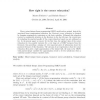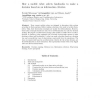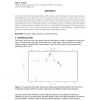26354 search results - page 163 / 5271 » How we refactor, and how we know it |
DISOPT
2008
13 years 10 months ago
2008
Given a mixed-integer linear programming (MILP) model and an optimal basis of the associated linear programming relaxation, the Gomory's corner relaxation is obtained by drop...
AROBOTS
2006
13 years 10 months ago
2006
Most current mobile robots are designed to determine their actions according to their positions. Before making a decision, they need to localize themselves. Thus, their observation...
DATASCIENCE
2007
13 years 10 months ago
2007
Astronomy is one of the most data-intensive of the sciences. Data technology is accelerating the quality and effectiveness of its research, and the rate of astronomical discovery ...
KI
2008
Springer
13 years 10 months ago
2008
Springer
The complexity of pedestrian spatio-temporal behaviour calls for the combination of several complementary empirical methods in order to comprehensively understand human motion beha...
IJON
2007
13 years 10 months ago
2007
Nearby neurons in the visual cortex often partially synchronize their spiking activity. Despite the widespread observation of this phenomenon, its importance for visual coding and...



